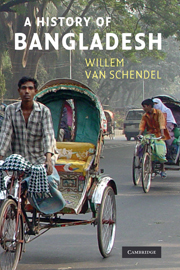Book contents
- Frontmatter
- Contents
- List of plates
- List of maps and figures
- Acknowledgements
- Timeline
- Introduction
- PART I THE LONG VIEW
- PART II COLONIAL ENCOUNTERS
- 5 From the Mughal empire to the British empire
- 6 The British impact
- 7 A closing agrarian frontier
- 8 Colonial conflicts
- 9 Towards Partition
- 10 Partition
- PART III BECOMING EAST PAKISTAN
- PART IV WAR AND THE BIRTH OF BANGLADESH
- PART V INDEPENDENT BANGLADESH
- Conclusion
- Bangladesh district maps
- Key political figures since 1947
- Glossary of Bengali terms
- Notes
- Bibliography
- Index
10 - Partition
Published online by Cambridge University Press: 05 February 2015
- Frontmatter
- Contents
- List of plates
- List of maps and figures
- Acknowledgements
- Timeline
- Introduction
- PART I THE LONG VIEW
- PART II COLONIAL ENCOUNTERS
- 5 From the Mughal empire to the British empire
- 6 The British impact
- 7 A closing agrarian frontier
- 8 Colonial conflicts
- 9 Towards Partition
- 10 Partition
- PART III BECOMING EAST PAKISTAN
- PART IV WAR AND THE BIRTH OF BANGLADESH
- PART V INDEPENDENT BANGLADESH
- Conclusion
- Bangladesh district maps
- Key political figures since 1947
- Glossary of Bengali terms
- Notes
- Bibliography
- Index
Summary
In the early 1940s, the Bengal famine had played havoc with the delta's social fabric. Now, in 1947, the Partition of India tore that fabric asunder. Without an understanding of Partition and its effects, it is not possible to make sense of contemporary Bangladesh. True, the shock of 1947 is no longer a living memory for the vast majority of Bangladeshis – but it created economic facts, historical myths and political mindsets that continue to haunt society today.
The Partition of India was a geographical solution to a political fiasco. The partitioner's knife cut through three provinces (Bengal, Assam and Punjab) and through innumerable trade routes and family ties. It created two long borders and left the partitioned societies in shambles, ruining millions of lives and upsetting cherished social arrangements. Many of the effects were unintended, unanticipated and long term.
The province of Bengal bore the full brunt: it was divided between the two new states. It is usually assumed that Bengal was cut in two. The reality is far more complicated: it was cut into no fewer than 201 pieces (Map 10.1). Pakistan received the largest part of the province's territory (64 per cent) and the majority of its population (65 per cent). Smaller sections to the west, north and east joined the new Republic of India, and the two states divided 197 tiny enclaves between them (see box‘Lives in limbo’).
- Type
- Chapter
- Information
- A History of Bangladesh , pp. 96 - 104Publisher: Cambridge University PressPrint publication year: 2009



